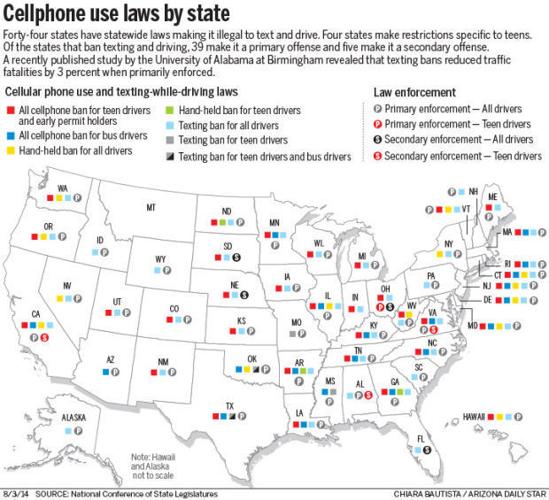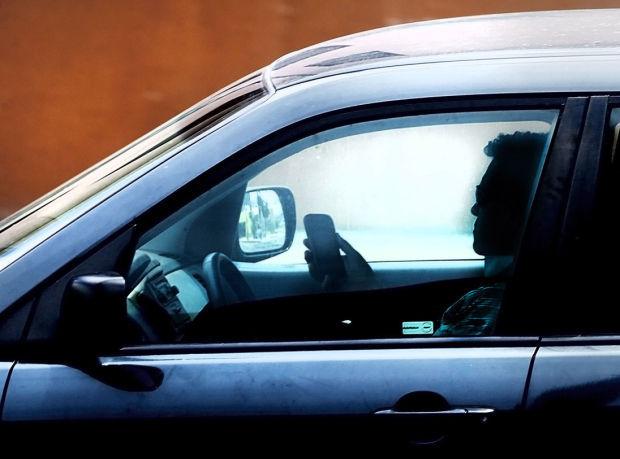We’ve all seen it. In the midst of city traffic a car swerves into your lane, and the driver suddenly jerks the wheels to correct. The driver’s head bobs up and down, hands clearly not on the steering wheel.
Texting and driving.
Inside city limits, that driver is breaking the law. But Tucson police officers have only issued 50 tickets for the violation in two years, a review of citations shows.
An officer can stop a driver suspected of using a phone to text, email or instant-message while driving. But the law, which took effect in April 2012, has proven difficult to enforce.
Tucson Police Officer Shawn Ramsey said he sees people texting and driving all the time, but he doesn’t stop a driver just for having a cellphone in hand because it’s too hard to prove someone was messaging or emailing at that moment.
“Someone could be driving down the road looking at pictures or watching a movie on the Internet,” he said, “and according to the city statue, that is not a violation.”
In his experience, most officers will only pull over someone who is drifting into other lanes, straddling the lines, or breaking other rules first, then issue a ticket for the texting violation if a driver admits to it. A more generalized law that makes using a phone for any reason illegal would cause tickets to “skyrocket,” Ramsey said.
The low number of citations shows the city’s texting ban isn’t doing much to influence people’s driving habits, said TPD Sgt. Eric Hickman.
“I would propose that 50 citations in two years kind of speaks for itself. I don’t know if that’s really influencing people’s behavior that much,” Hickman said.
City Councilman Steve Kozachik, who supported the bill during its creation, said that despite the low citation rate, the ordinance is improving public safety.
“In my world, that’s 40 or 50 prevented accidents,” Kozachik said. “For those 40 or 50, we’re saving lives.”
Cellphone use by drivers was a factor in more than 100 highway crashes during a six-month period, new numbers from the Arizona Department of Public Safety show.
Kozachik said he would like to see officers be more proactive, but concedes it can be hard for them to focus on texting and driving while also enforcing other moving violations.
Officers don’t get special training to learn what it looks like when a driver is texting.
University of Arizona student Bailey Lahtinen is from Phoenix, where texting and driving in city limits is also illegal.
She admits to doing it herself sometimes, but tries not to because it is “distracting and dangerous.”
Lahtinen said she sees more people doing it in Phoenix than Tucson, and even more people taking the risk on the freeways. She said a statewide law would help deter that behavior.
“I think if it’s enforced more, then that will spread the word,” Lahtinen said.
More public-service and advertising campaigns should point out the clear dangers of using cellphones while driving, said Brendan Lyons, founder of Look! Save a Life/Arizona. The issue needs more enforcement, but also more education to be impactful, he said.
“There are so many people that get behind the wheel and say, ‘This isn’t going to happen to me. I can read this message,’” Lyons said. “It’s really a mind boggle to me.”
NO STATEWIDE BAN
Arizona is one of only two states with no statewide texting-while-driving ban. It’s illegal for all drivers in 44 states, and four states make it illegal for teen drivers.
State Sen. Steve Farley, a Democrat, has tried to pass legislation since 2007 banning texting and driving in the state. Various bills have been aimed at different restrictions — like certain age limits and the imposition of stricter fines — but the bills went nowhere, Farley said. He and others, including Kozachik, blame political agendas.
For example, two bills introduced last year, including one from Farley, never had a committee hearing scheduled.
“It’s really common sense to anybody,” Farley said. “It’s just something we should be doing to make sure our roads are as safe as possible for anyone to use them.”
Farley has been outspoken on the need to implement a more stringent and effective law to deter distracted driving. He also believes greater enforcement of stopping distracted driving, not just putting a stop to texting and driving, should be more of a priority in Arizona.
National studies are mixed on whether state bans are effective.
A 2010 study by the Insurance Institute of Highway Safety said texting-and-driving bans for all drivers are not effective in reducing the number of collisions. IIHS spokesman Russ Rader said the study provides evidence that drivers are using their phones less, but the risk of crashing hasn’t gone down.
He said education programs to raise drivers’ awareness may help, but laws alone don’t seem to be effective.
“You need to have the law, you need to have enforcement, and you need to have education,” Farley said.
Actually, more accidents may happen in states with bans because drivers try to hide their phones, further diverting their attention, Rader said.
A study by researchers at the University of Alabama at Birmingham published in July revealed bans are most effective in reducing crashes when officers are allowed to stop a driver for texting as a primary offense. The study indicated those bans were “significantly associated with a 3% reduction in traffic fatalities in all age groups.”
Lyons said the threat of citations and fees should not be the reason people keep their phones put away while driving.
“It’s like having integrity,” Lyons said. “You have to do the right thing when nobody else is watching, and that goes with texting and driving. That goes with anything.”
While legislation aimed at texting bans has been repeatedly ignored in the Arizona Senate, the wide range of distractions for drivers is a huge public safety concern.
In the U.S., 35 states ban cellphone use for teen drivers, and 20 states ban bus drivers from using them. Twelve states make it illegal to have a phone in hand, while five ban teens or bus drivers from having one in hand.
The state DPS released data in April showing distracted driving, including texting and driving, results in thousands of accidents each year. From November 2013 to mid-April 2014, DPS reported more than 10,000 crashes. Nearly 1,600 resulted from distracted driving — 127 a result of cellphone use. Ten of the crashes caused by distracted driving were fatal.
Distractions besides cellphone use include reaching for items in the car, talking to passengers, and fiddling with the radio — all actions that divert driver’s attention from the road, DPS spokesman Bart Graves said.
“Here in Arizona, we’re going from call to call to call about the other driver in the car being distracted,” Graves said. “All these factors we deal with on a daily basis are a result of people not paying attention.”






